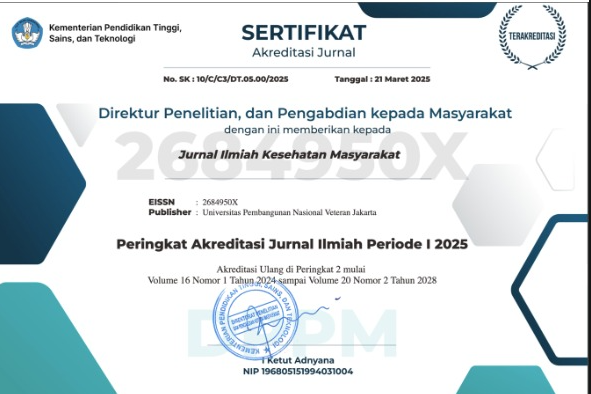Efektivitas Jaringan Komunikasi Masyarakat Terhadap Upaya Pencegahan Kejadian Stunting Di Desa Cikulur Kabupaten Lebak Provinsi Banten Tahun 2019
Abstract
Latar belakang: Prevalensi stunting di Provinsi Banten sebesar 33%, yang terdiri dari 16,4% sangat pendek dan 16,6% pendek. Kabupaten dengan prevalensi stunting tertinggi kedua di Banten adalah Kabupaten Lebak (38,1%), yakni sangat pendek 16,7% dan pendek 21,4%. Adanya fasilitas kesehatan dan jaringan komunikasi ini berfungsi untuk mendeteksi dini malnutrisi pada suatu daerah. Peran ini dapat dikembangkan untuk pemanfaatan sarana- prasarana di wilayah terkait untuk penyebaran informasi serta kemudahan akses dan peran aktif masyarakat, serta kader posyandu. Hal tersebut dapat memengaruhi kesehatan ibu untuk secara rutin mengecek tumbuh kembang anak. Keefektifan suatu kelompok mampu dipengaruhi oleh karateristik kelompok melalui jaringan komunikasi untuk mengetahui pemuka opini (Opinion Leader) dan aktor dari jaringan serta keefektifan penyerapan informasi mengenai stunting yang diintervensi oleh pemuka opini jaringan komunikasi, dan yang diintervensi dengan metode konseling, pembinaan dan pemberdayaan.
Metode: Metode penelitian kualitatif deskriptif, dengan menggunakan pendekatan realis. Pendekatan realis yaitu melihat jaringan dari perspektif responden (Aktor), dimana aktor yang akan menentukan sendiri posisisnya dalam jaringan.
Hasil: Hasil penelitian yang menggunakan teknik wawancara mendalam dengan masyarakat menemukan terdapat empat individu yang banyak dipilih oleh masyarakat. Keempat individu tersebut merupakan pemuka opini (Opinion Leader) yang aktif dalam memberikan informasi terkait masalah kesehatan diantaranya masalah stunting, mampu memberikan motivasi kepada anggota keluarga serta masyarakat.
Kesimpulan: Dengan melakukan komunikasi, pemuka opini (Opinion Leader) yang berisikan informasi serta motivasi dalam setiap kegiatan dapat menumbuhkan upaya preventif yaitu pencegahan awal terjadinya masalah stunting serta meningkatakan derajat kesehatan masyarakat.
Kata Kunci: Jaringan Komuniasi, Pemuka Opini (Opinion Leader) Stunting, kesehatan.
Effectiveness of Communication Network Toward Prevention of Stunting in Cikulur Village, Lebak District, Banten Province
Abstract
Background: Prevalence of stunting in Banten Province was 33%, consisting of 16.4% very short and 16.6% short. The district with the second highest stunting prevalence in Banten is Lebak (38.1%), which is very short 16.7% and short 21.4%. Health facilities and communication networks serves to detect early malnutrition in an area which can be developed for the utilization of infrastructure in related areas for the dissemination as well as ease of access and the active role of the community, and posyandu cadres. This can affect maternal health to check the growth and development of children routinely. The effectiveness is influenced by group characteristics as communication network aimed at knowing opinion leaders (Opinion Leaders) and actors from the network as well as the effectiveness of information absorption on stunting that is intervened by the communication network opinion leaders, and which is intervened by the counseling method, coaching and empowerment.
Methods: Descriptive qualitative research methods, using a realist approach. The realist approach is to look at the network from the perspective of the respondent (Actor), where the actor will determine his own position in the network.
Result: The results of research using in-depth interviews with the community found that there were four individuals who were chosen by the community. The four individuals are opinion leaders (Opinion Leaders) who are active in providing information related to health issues including stunting issues, able to provide motivation to family members and the community.
Conclusion: By conducting communication, opinion leaders (Opinion Leaders) that contain information and motivation in each activity can foster preventive efforts, namely the early prevention of stunting problems and increasing the degree of public health.
Keywords: Communion Network, Stunting Opinion Leader, health.
References
W J. Perilaku makan anak sekolah Direktorat Bina Gizi Kementerian KesehatanRepublik Indonesia [Internet]. 2018 [cited 2018 Jul 22]. Available from: http://gizi.depkes.go.id/makalah/downloa d/perilaku makan anak sekolah.pdf
UNICEF. United Nations and Children’s Fund.Infant and Young Child Feeding. New York; 2011.
WHO. WHA Golobal Nutrition Targets 2025 : Anaemia Policy Brief. 2014.
WHO. World Health Organization LGBT Report: Globalhealth.gov [Internet]. 2013 [cited 2018 Jul 26]. Available from: http://www.globalhealth.gov/global- health topics/lgbt/lgbt_report.html
RI K. Riskesdas dalam Angka Provinsi DKI Jakarta 2013. Jakarta: Lembaga Penertbitan Badan Penelitian dan Pengembangan Kesehatan Kemenkes RI; 2013.
Farmasi PB dan. Puslitbang Biomedis dan Farmasi. Jakarta; 2009.
Marifat. Analisis Hubungan Pemanfaatan Pelayanan Kesehatan dengan Status Gizi Anak Balita. Bogor. 2010.
Agustina. Efektifitas Jaringan Komunikasi Remaja Akhir Putri Sebagai Intervensi Peningkatan Pengetahuan 1000-HPK. Universitas Pembangunan Nasional Veteran Jakarta; 2016.
Nursalam. Konsep dan Penerapan Metodelogi Penelitian Ilmu Keperawatan. Jakarta: Salemba Medika; 2008.
Eryanto. Analisis Jaringan Komunikasi. Jakarta: Prenada Media; 2014.
Rogers EM. Diffusion of Innovations. London: The Free Press; 1983.
Saifuddin AB. Ilmu Kebidanan. Jakarta: Bina Pustaka Sarwono Prawhardjo; 2010.
Wellina, W. F., Kartasurya, M. I., & Rahfiludin, M. Z. (2016). Faktor risiko stunting pada anak umur 12-24 bulan. Jurnal Gizi Indonesia (The Indonesian Journal of Nutrition), 5(1), 55-61.
Mendez, M. A., & Adair, L. S. (1999). Severity and timing of stunting in the first two years of life affect performance on cognitive tests in late childhood. The Journal of nutrition, 129(8), 1555-1562.
Hizni, A., & Julia, M. (2009). Hubungan status stunted dengan perkembangan balita di wilayah pesisir pantai utara Kecamatan Lemahwungkuk Kota Cirebon. Doctoral dissertation. Yogyakarta: Universitas Gadjah Mada.
Kandeepan, K., Arasaratnam, V., & Balakumar, S. (2016). Nutritional status and food insecurity among the children in Northern Sri Lanka.









.jpg)








